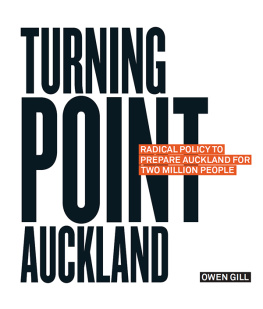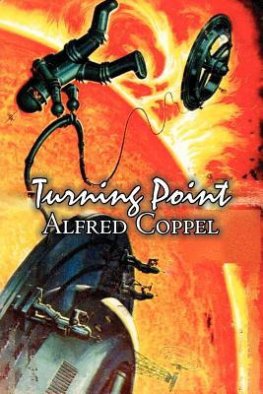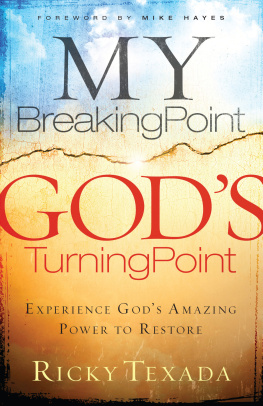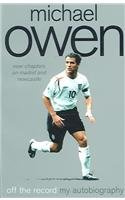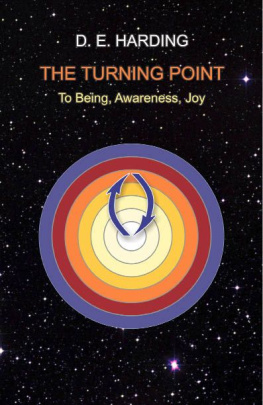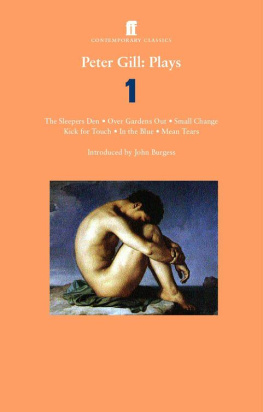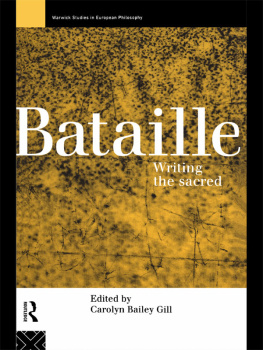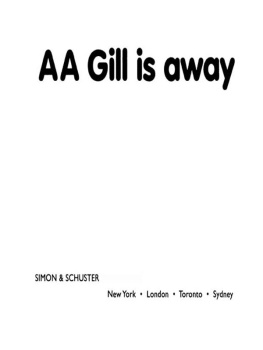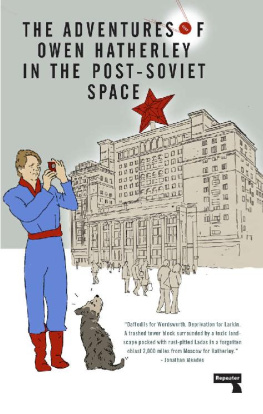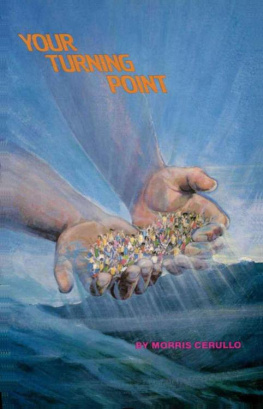Owen Gill - Turning Point Auckland
Here you can read online Owen Gill - Turning Point Auckland full text of the book (entire story) in english for free. Download pdf and epub, get meaning, cover and reviews about this ebook. publisher: Oratia Books, genre: Politics. Description of the work, (preface) as well as reviews are available. Best literature library LitArk.com created for fans of good reading and offers a wide selection of genres:
Romance novel
Science fiction
Adventure
Detective
Science
History
Home and family
Prose
Art
Politics
Computer
Non-fiction
Religion
Business
Children
Humor
Choose a favorite category and find really read worthwhile books. Enjoy immersion in the world of imagination, feel the emotions of the characters or learn something new for yourself, make an fascinating discovery.
Turning Point Auckland: summary, description and annotation
We offer to read an annotation, description, summary or preface (depends on what the author of the book "Turning Point Auckland" wrote himself). If you haven't found the necessary information about the book — write in the comments, we will try to find it.
Turning Point Auckland — read online for free the complete book (whole text) full work
Below is the text of the book, divided by pages. System saving the place of the last page read, allows you to conveniently read the book "Turning Point Auckland" online for free, without having to search again every time where you left off. Put a bookmark, and you can go to the page where you finished reading at any time.
Font size:
Interval:
Bookmark:

Published by Urban Hymns Publishing, Titirangi, Auckland 0604
Copyright 2019 Owen Gill
Copyright 2019 Urban Hymns Publishing (published work)
The copyright holder asserts his moral rights in the work.
This book is copyright. Except for the purposes of fair reviewing, no part of this publication may be reproduced or transmitted in any form or by any means, whether electronic, digital or mechanical, including photocopying, recording, any digital or computerised format, or any information storage and retrieval system, including by any means via the Internet, without permission in writing from the publisher. Infringers of copyright render themselves liable to prosecution.
ISBN 978-0-473-46550-6 (print)
ISBN 978-0-473-46685-5 (e-book)
ISBN 978-0-473-46686-2 (Kindle)
ISBN 978-0-473-46687-9 (pdf)
Publishing services: Oratia Media, www.oratia.co.nz
Design: Strategy Creative
Photographs: Bruce Clarke and Patrick Gailer at Incredible Images (Auckland); NZME Newspix and New Zealand Herald; Glenn Hailstone at Hailstone Aerial Films (Auckland); Mark Scowen, Mark Scowen Photography (Auckland); Andrew L. Moore (Detroit); Alexander Turnbull Library (Wellington); back flap image by Jen Leheny, Red Instead (Canberra)
First published 2019
Printed in New Zealand
ACKNOWLEDGEMENTS
The ideas of four writers on cities are reflected in this book. They are Bruce Katz and Jeremy Nowak (The New Localism); Edward L. Glaeser (Triumph of the City) and Richard Florida (The New Urban Crisis).
I am also a fan of Joel Kotkin, who has written extensively on cities. Kotkins ideas are suffused here.
In the course of writing this book, I was taken back to the 1995 classic The Winner Take-All Society by Robert H. Frank and Philip J. Cook. It is as relevant today as when it was first published.
Peter Wilson at the NZ Institute of Economic Research (NZIER) assisted with the examples of the effects of Auckland Councils rates policy, and journalist Simon Wilson commented on the overall arguments in this book. I am grateful to both.
Paul Hewlett, a long-standing friend and colleague, read an early draft, and encouraged me to continue.
Graeme Scott, a notable Auckland architect, provided many insights into Aucklands built environment. One of the ideas in this book is his; that is to suspend the Resource Management Act 1991 in Auckland and replace it with an Auckland development act, supported by the Auckland Plan. He generously agreed I could include it.
Notwithstanding the above, I am responsible for the ideas in the following pages and for any errors.
Owen Gill
November 2018
LAST, LONELIEST, LOVELIEST, EXQUISITE, APART.
Rudyard Kipling, referring to Auckland, Song of the Cities, 1891
INTRODUCTION
ASMANNS WORLD
AT 11.08 A.M. ON 6 FEBRUARY 2027, Asmann was born in the obstetrics wing of the Tmaki Makaurau Western City Hospital. The hospital had been opened a year before, on the gentle slopes of Westgate, with the upper reaches of the Waitemata Harbour in sight, and 15 kilometres in a straight line to the shores of the Tasman Sea. Outside, the downs of Westgate were home to 20,000 people, 2000 of whom also worked in the smart industries that had set up in the surrounding new digital industries zone.
Asmanns parents had immigrated to New Zealand in 2004, as children, from Afghanistan. Both had been resettled as refugees, escaping the post-9/11 war that was tearing Afghanistan apart. They were made citizens in 2008, around the time that Prime Minister Helen Clarks Government went out of office.
Apart from the story of her parents and their escape from Afghanistan, not much distinguished Asmann from the thousands of other children born in Auckland that year. Like Asmanns parents, 40 percent of Aucklanders traced their origins to Asia. The obstetrics team that delivered her was comprised of New Zealanders who traced their origins to Korea and the Philippines. One nurse on the team was Mori, and another was the daughter of Samoan New Zealanders.
The obstetrics team had used a bipedal medical robot, Georgie, during the delivery, mostly to carry equipment. As soon as Georgie was satisfied that the baby was healthy, she had called Asmanns father on a constant, high-definition Internet connection to tell him the good news. He had been unable to get to the hospital in time.
Georgies emotional intelligence software selected the right tone of voice for giving humans favourable news. The software selected New Zealand English, but Georgie could also have delivered the news in the fathers native language if it had been required.
One thing did distinguish Asmann, although it would not become apparent until a few weeks later, when Statistics New Zealand completed its quarterly count of New Zealanders using digital technology that gave up-to-the-minute census data accurate to one decimal place.
Asmann was the two-millionth Aucklander. Her birth pushed Auckland past a critical population point.
In the 25 years since her parents had landed in Auckland, the city had grown from 1.2 million people to two million. After 2020, new centres, each accommodating 4050,000 people, had sprung up to the south and west of Auckland. A second airport was under construction near Dairy Flat.
In the centre of Auckland, close to 2500 people lived in the new high-density site called Maruru, where the Port of Auckland had once been. Another 500 lived across the harbour in huru Mwai, where the Devonport Naval Base had been. To the north, the former industrial site of Wairau Valley had been converted to an open public space that provided an immense urban park, including 20 kilometres of tracks and cycleways.
Outside the Tmaki Makaurau Western City Hospital, the new New Zealand flag with its distinctive red-black-green AsiaPacific design swung from the flagpole. In a few days New Zealanders would start voting for the first locally appointed head of state, the Governor of New Zealand.
Asmann does not exist, but her story is plausible.
In 2018, Auckland is home to almost 1.7 million people. At current growth rates it will pass two million people sometime in the ten years following 2022. In all likelihood the two millionth Aucklander will be someone like Asmann.
This book is for two groups of people: all of the Asmanns who will come and what we must do to prepare the way for them, and the people who live in Auckland now and who wonder what we can do to make substantive improvements to the city.
As it is currently organised, Auckland will barely provide for Asmann and her siblings. Affordable houses will continue to be in short supply and Auckland will be an expensive place to live. Auckland will remain a city dependent on cars, with its head bowed reverentially towards its motorways and intersections. Public transport will have improved, but it will only just keep pace with the growing population.
Aucklands economy will remain suspended between the twentieth and the twenty-first century, with many workers still working in the industries of the past. Artificial intelligence will be helping some Aucklanders, but to many it will appear as a threat.
Aucklands natural environment with its city balanced between the Kaipara, Waitemata and Manukau harbours, the Waitakere Ranges to the west, the Hauraki Gulf and the Gulf islands to the east will be recognised globally. But keeping that environment intact and accessible for Aucklanders will be an ever-tougher battle.
Dont misunderstand me. I dont think Auckland will become an undesirable or dangerous place to live. It will muddle along, falling below what it could be.
Next pageFont size:
Interval:
Bookmark:
Similar books «Turning Point Auckland»
Look at similar books to Turning Point Auckland. We have selected literature similar in name and meaning in the hope of providing readers with more options to find new, interesting, not yet read works.
Discussion, reviews of the book Turning Point Auckland and just readers' own opinions. Leave your comments, write what you think about the work, its meaning or the main characters. Specify what exactly you liked and what you didn't like, and why you think so.

